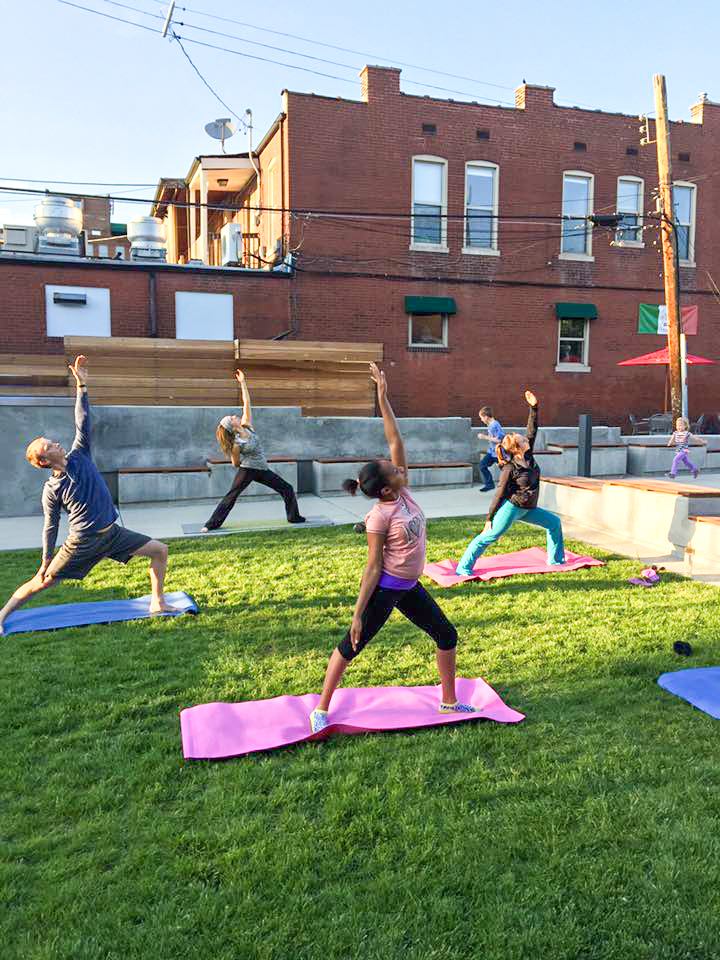
This article was written by Rachel Witt, Executive Director of the South Grand Community Improvement District. Read all the articles in the Lessons & Partnerships in Community & Economic Development series.
It was proven early on during the pandemic that we could physically see the difference in our air quality when cars were off the roads. To the human eye the air looked crisp and in areas where people had never seen them, their mountain range was as clear as day. This is strong evidence that when we have large volume of cars on the road, we are causing air pollution. The number of cars idling, and clogging traffic are increasing our climate problems.
Imagine if you can decrease the number of hours spent in your vehicle commuting to work. Anyone would want to get their lost time back to utilize in ways that make them happier. The result is our mental health will improve as we become more productive in the way we live and work. This change begins by studying traffic patterns, where people live and where they are commuting. When traffic patterns change, a new network is created resulting in new jobs. Thus, we can tackle traffic and at the same time improve mental health and spur job growth.
First, we need to gather the data of those who are traveling on our roads. Where are they going? If we can change their drive time and their number of trips, we can tackle congestion. The pandemic also proved we can do our job from home. If remote working is not an option, can we stagger start times? If most companies have their employees start at the same time, we are causing traffic congestion on our roads. The goal is to work with our Chamber of Commerce to study start times, travel time, and roadways that are being overtaken by vehicles, in order to reduce the number of cars on the road traveling at the same time. Also, creating a four-day work week can help decrease the number of our commutes. Lastly, can incentives be provided to those who walk, bike, or take transit to work? All these types of initiatives will improve our nation’s mental health and spur job growth.
For instance, neighborhoods that score low on walkability and sense of place can become a place to grow entrepreneurship to live, work, and play in these neighborhoods. This concept to grow entrepreneurship and workforce development can be accomplished with the support of the Department of Transportation, Department of Housing and Urban Development, and Small Business Administration. The combination of federal departments resources can help with traffic congestion and change the way we interact with our environment. The results can decrease traffic and increase mental health and spur job growth. To secure funds from the federal government a regional strategic plan will need to be created as well as unifying a region to have one vision and goal to change traffic patterns to improve mental health and programs to spur job growth.
Imagine if companies permanently allow their employees to work from home or set up shared workspaces close to their homes, can this be a solution to tackle traffic congestion? For instance, instead of leasing out one large office that is centrally located, creating a shared workspace close to home would decrease commute time. Companies would no longer lease in a central location but create multiple satellite offices around the region. While this concept is not a solution for all cities, highly congested cities and outer suburbs can really help tackle traffic congestion by applying this concept.
A live/work environment increases spending in neighborhoods and improves main streets vitality, too. Thus, the creation of the 15-minute city. The cost of living is getting out of control and with inflation at the rate it is today, an adjustment in how we live, work, and play needs to be factored in on livability standards. The 15-minute city needs to be a priority in overpopulated areas. Having goods, services, and health care within 15 minutes of your home is an incentive for those to live, work, and play in such a community. The result will help improve traffic congestion and air quality.
This is a large undertaking. A lot of data needs to be collected to help determine the traffic flow. Adding traffic lanes won’t solve the problem; it just increases sprawl. Imagine the quality of life for all if we decreased the number of traffic lanes. The results are better health for all as well as a decrease in roadway maintenance cost throughout the country.
As we work our way out of the pandemic, our needs and wants have changed. The way we work and socialize needs to be a priority in how we commute. For instance, by creating satellite offices throughout the region, employees can walk, bike, or take a short transit ride to their office. Also, placing satellite offices near parks will give employees time to take a walk or bring their lunch.
Placing offices near main streets provides an opportunity for co-workers to go out to lunch together, take a yoga class or conduct shopping during their lunch break or after work. The creation of a new grid on where offices are created will decrease commute time. Sitting in less traffic will improve our mental health as well as our productivity. Will you be the champion in your community? Together we can tackle traffic congestion and at the same time aid in mental health and job growth.

Rachel Witt is the Executive Director of the South Grand Community Improvement District. Graduate from Southern Illinois University Edwardsville with a Bachelor of Science Degree in Geography, minor in Sociology and certification in Nonprofit Management. Master’s in public administration from Widener University emphasis in local government and economic development. Connect with Rachel on Linkedin or Email.
